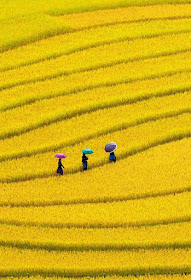 |
| Rice field |
Rice, the starchy seeds of an annual cereal grass, is the most commonly consumed food grain for a majority of the world’s population.
The rice plant, Oryza sativa, is a member of the grass family, classified into indica and japonica varieties. World production of rice exceeds 500 million tons. Most countries—particularly in Asia—cultivate rice for domestic consumption, so less than 5 percent enters the export market.
The United States generates only about 2 percent of world rice production, but almost half of U.S. production is exported. Rice cultivation almost certainly began in India, where it dates back to about 3000 b.c.e. During medieval times it spread westward to southern Europe.
  |
Cultivation
Monsoon tropics are ideal for indica rice, which is commonly cultivated in China and Southeast Asia. The plants can adapt to uncertain conditions.
The japonica type of rice requires precise water control as well as weed and insect control. It is cultivated in temperate zones such as the United States, Australia, Japan, Korea, and certain parts of China.
Rice is self-pollinated, and the grain is enclosed in the palea, or hull. Harvested but unmilled rice is called paddy or rough rice. Milling of rough rice by any of several processes yields the polished grain that is ready for consumption.
Rough rice contains approximately 10 percent protein, 65 percent starch, 2 percent lipids, 5 percent minerals, and 18 percent hull/bran. The unhulled whole rice kernel also contains thiamine, niacin, and riboflavin. Parboiled rice can be stored for long periods.
The International Rice Research Institute in the Philippines has contributed significantly to the development of high-yielding types of rice, beginning in the mid 1960’s. The development of these plants is considered a significant part of the 1960’s Green Revolution in agriculture.
Some of these varieties demand complete irrigation systems year-round that help keep the soil submerged under about 6 inches (15 centimeters) of water. Next to corn, rice provides the farmer with the greatest yield when plants are cultivated with the necessary care. The crop grows well in irrigated and flooded areas.
Cooked rice is mostly consumed in its whole grain form. Puffed rice and flaked rice are common breakfast cereals, and rice flour is used in bakery products. Laundry starch is made from rice starch.
Rice hull is used in cattle feed as well as fertilizers. The rice plant produces oil for food and industry and that ching material for roofs and mats. The Japanese alcoholic beverage sake is made from a process that involves the fermentation of rice.
Wild Rice
The plant commonly known as wild rice, Zizania aquatica, is actually a separate genus found in North America. Like rice, wild rice is an annual grass, and it grows mostly in lakes and streams. Lakes in Minnesota, Wisconsin, and southern Canada provide a good harvest of wild rice. Wild rice, once a staple of the diet of American Indians in those regions, has become a popular side dish.
